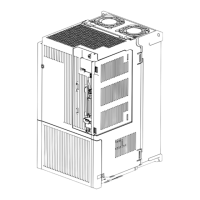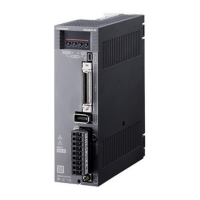What does linear encoder error 2 mean on Mitsubishi MR-J4-200A Amplifier?
- TTodd MilesSep 23, 2025
Linear encoder error 2 on your Mitsubishi Amplifier is due to a linear encoder environment error.

What does linear encoder error 2 mean on Mitsubishi MR-J4-200A Amplifier?
Linear encoder error 2 on your Mitsubishi Amplifier is due to a linear encoder environment error.
What causes an overspeed error on a Mitsubishi Amplifier?
An overspeed error on your Mitsubishi Amplifier is caused by abnormal motor speed.
What causes a main circuit error in my Mitsubishi MR-J4-200A?
A main circuit error in your Mitsubishi Amplifier can occur due to:* A ground fault detected by the hardware detection circuit.* A ground fault detected by the software detection function.
Why is my Mitsubishi Amplifier showing a servo motor overheat error?
A servo motor overheat error in your Mitsubishi Amplifier can be due to:* Abnormal temperature of servo motor 1.* Abnormal temperature of servo motor 2.* Thermistor disconnected error.* Abnormal temperature of servo motor 3.* Abnormal temperature of servo motor 4.
What causes undervoltage on Mitsubishi MR-J4-200A Amplifier?
Undervoltage in your Mitsubishi Amplifier can be due to:* Voltage drop in the control circuit power.* Voltage drop in the main circuit power.
What does servo motor combination error mean on Mitsubishi MR-J4-200A Amplifier?
A servo motor combination error on your Mitsubishi Amplifier can refer to a servo motor combination error or a servo motor control mode combination error.
What does encoder initial communication error 3 mean on Mitsubishi MR-J4-200A Amplifier?
Encoder initial communication error 3 on your Mitsubishi Amplifier indicates an incompatible encoder or an incompatible load-side encoder.
What does memory error 3 mean on Mitsubishi MR-J4-200A?
Memory error 3 (FLASH-ROM) on your Mitsubishi Amplifier indicates either FLASH-ROM error 1 or FLASH-ROM error 2.
What does memory error 2 mean on Mitsubishi MR-J4-200A?
Memory error 2 (EEP-ROM) on your Mitsubishi Amplifier can occur due to:* EEP-ROM error at power on.* EEP-ROM error during operation.
What does encoder normal communication error 2 mean on Mitsubishi MR-J4-200A?
Encoder normal communication error 2 on your Mitsubishi Amplifier can be caused by:* Encoder data error 1.* Encoder data update error.* Encoder data waveform error.* Encoder non-signal error.* Encoder hardware error 1.* Encoder hardware error 2.* Encoder data error 2.
| Type | AC Servo Amplifier |
|---|---|
| Series | MR-J4 |
| Model | MR-J4-200A |
| Rated Output | 2.0 kW |
| Voltage Class | 200 V |
| Position Control | Yes |
| Speed Control | Yes |
| Torque Control | Yes |
| Full-closed control | Yes |
| STO | Yes |
| Communication | SSCNET III/H |
| Protection functions | Overcurrent, Overvoltage, Overheating |
| Ambient Temperature | 0 to 55 °C |
| Ambient Humidity | 90% RH or less (non-condensing) |
| Vibration Resistance | 5.9 m/s² (0.6 G) at 10-55 Hz |
| Cooling Method | Natural Cooling |
Crucial safety instructions to prevent electric shock during wiring, operation, and inspection.
Safety precautions to prevent fire hazards related to installation and component usage.
Details regarding the input power supply circuit requirements and connection for various voltage classes.
Provides examples of connecting I/O signals for different control modes like position, speed, and torque.
Explains the forced stop deceleration function (SS1) and its connection requirements.
Illustrates timing charts for alarm occurrences, showing the sequence of events.
Provides essential guidelines for proper grounding of the servo amplifier and motor to prevent electrical shock.
Detailed technical specifications for the MR-J4 servo amplifier series, including voltage, current, and performance.
Outlines the procedure for initial power-on startup.
Details the critical checks required for power supply and motor wiring before initial power-on.
Provides detailed explanations for various parameter groups, including basic, gain/filter, extension, and I/O settings.
Discusses various methods for adjusting servo gains, including auto tuning and manual modes.
Explains how to perform automatic gain adjustment using one-touch tuning via software or push buttons.
Covers auto tuning modes 1 and 2, including their operating principles and parameter adjustments.
Describes functions that allow continued operation even under alarm conditions, including vibration and power failure tough drive.
Illustrates overload protection characteristics for various servo motors and their combinations with servo amplifiers.
Explains dynamic brake operation, including coasting distance calculation and time constants.
Outlines the specifications and system requirements for using MR Configurator2 software.
Explains the selection and connection of external dynamic brakes for specific servo amplifier models.
Outlines the step-by-step procedure for starting up the absolute position detection system.
Details the protocol for transferring absolute position data between the servo amplifier and controller.
Lists and explains potential errors during absolute position data transfer.
Outlines residual risks associated with the STO function and manufacturer responsibilities.
Lists the specifications related to functional safety, performance, and CE marking of the STO function.
Details the STO I/O signal connector (CN8) and its pin configurations for signal layouts.
Illustrates connection examples for the STO function using safety logic units and relays.
Details crucial precautions for using communication functions to prevent electrical shock and equipment malfunction.
Provides detailed explanations of command processing, including data conversion and examples.
Covers essential safety precautions, wiring guidelines, and signal explanations for linear servo motors.
Covers safety precautions, wiring guidelines, and signal explanations for direct drive motors.
Explains the requirements and procedures for absolute position detection with direct drive motors.
Shows representative electrical installation and configuration examples for 200V and 400V class servo amplifiers.
Lists technical data for MR-J4 servo amplifiers, including electrical specifications and safety compliance.












